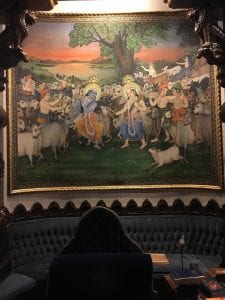On the evening of Wednesday February 8th 2017, my classmates and I had the unique opportunity to visit the International Society for Krishna Consciousness (ISKCON) Temple in Dallas, Texas. Founded by A.C. Bhaktivedanta Swami Prabhupada, the Hare Krishna movement had its inception in New York City in 1966 during what is commonly referred to today as the counterculture movement. Since then, it has amassed a significant devotee base throughout the globe. Upon entering the temple and specifically the main worship room, one is nearly met with a sensory overload, an intentional and important aspect of the Hare Krishna faith. The strong smell of incense, the sound of soft music and hymns, the magnificence of the worship room itself, lined with astonishing woodworked pillars, massive and precisely detailed paintings depicting different periods of Krishna’s life events; as our class had to come learn, this stimulation of the senses plays an integral role in the worshipping rituals for the Hare Krishna faith.
Our tour guide Prajapati was an extremely welcoming and charismatic man and was even an original member of the movement, having personally known and learned from Prabhupada. Whereas in other religions, worshipping God is done with an emphasis often more so on offerings and fear, Prajapati enlightened us on how worshipping Krishna is markedly distinguishable in that it is worshipping God (Krishna) with the primary emphasis on devotion and love. “Krishna tells us in the Gita (9:26) that he will accept whatever is offered with devotion” and Prajapati emphasized the importance of the sensory stimulation as the means to forsake all thoughts of the material world to fully devote oneself to Krishna, offering what one is willing and able to offer.[1] Throughout the tour, devotees of all ages and backgrounds strolled in and out of the room, paying one’s respects to Krishna through various acts such as kneeling, lying flat on the floor, and even kissing the floor before the statue of Prabhupada. I found this concept and primary emphasis on devotion rather than offering particularly interesting, as it seemed to oppose the primary emphasis that faiths like Christianity seem to have on offerings.
Growing up, I have been fortunate enough to be exposed to a variety of faiths and perspectives, from attending a Lutheran high school, to certain services at Jewish temples to visiting Buddhist temples while studying abroad in China. After visiting the Hare Krishna temple, I have gained yet another perspective on what faith and religion mean to people. Every time that I have entered each respective faith’s house of worship, I am always enticed by a feeling of curiosity. This experience certainly was a memorable way to continue exposing myself to the many perspectives on life and faith in the world, breaking out of the bubble that many seldom burst.
The following pictures are from the tour itself and include the lifelike statue of Hare Krishna founder A.C. Bhaktivedanta Swami Prabhupada (left) and a depiction of Krishna with some of his followers protecting the sanctity of cows’, bulls’, and calves’ lives, a practice heavily emphasized in Hare Krishna (right).

[1] Hopkins, Thomas J. “ISKCON’s Search for Self-Identity: Reflections by a Historian of Religions.” The Hare Krishna Movement: Forty Years of Chant and Change, edited by Graham Dwyer and Richard J. Cole, 2007.

